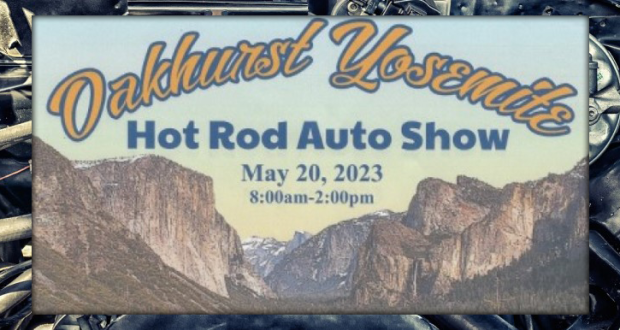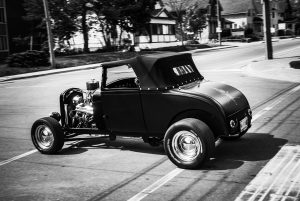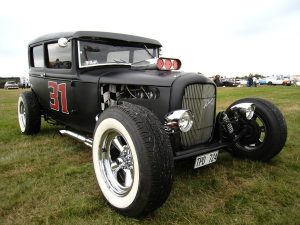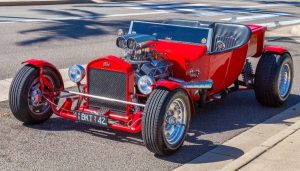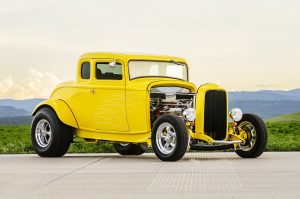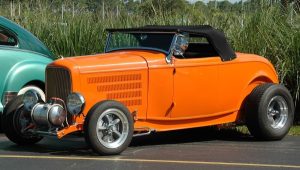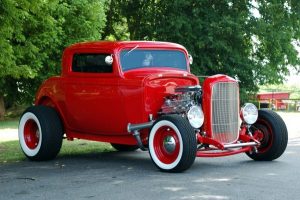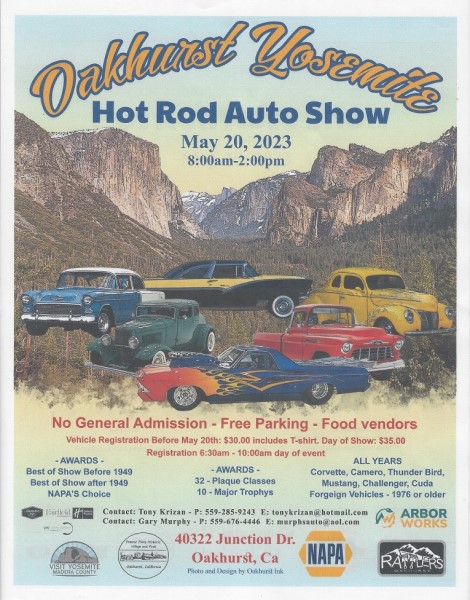OAKHURST — Start revving your engines, everyone! The Oakhurst Yosemite Hot Rod Auto Show is coming to Oakhurst next weekend! There’ll be (literally) tons of cars as well as some awesome food! It’s going to be a great time for the entire family so we’ll see you there!
Date & Time: Saturday, May 20, 2023, from 8 a.m. to 2 p.m.
General admission is free.
Vehicle registration begins at 6:30 a.m and ends at 10 a.m.
Vehicle registration fee before May 20th is $30 and includes a free T-shirt. Registration on day of show is $35.
For more information, please contact:
- Tony Krizan at 559-285-9243 or tonykrizan@hotmail.com.
- Gary Murphy at 559-676-4446 or murphysauto@aol.com.
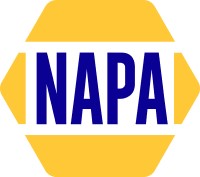 NAPA Auto Parts
NAPA Auto Parts
40322 Junction Drive
Oakhurst, CA 93644
559-683-7440
A Brief History of the Hot Rod
The hot rod, a classic American car, is a symbol of speed, power, and innovation. From the early days of automobile manufacturing, people have been tinkering with engines, tweaking performance, and pushing their cars to the limits of what was possible. This passion for speed and customization gave rise to the hot rod, an iconic part of American automotive culture.
The origins of the hot rod can be traced back to the early days of automobile manufacturing in the United States. Cars in the early 1900s were large, cumbersome machines that were designed primarily for transportation. However, as the technology behind these machines improved, so too did their potential for speed.
The first hot rods were built by young men who were passionate about cars and racing. They were often built from old, worn-out cars that had been left to rust in junkyards. These young men would strip these cars down to their bare essentials, replacing heavy parts with lighter ones, adding powerful engines, and souping up the suspension to make them faster and more nimble.
One of the earliest pioneers of the hot rod was a young man by the name of Bob Rufi. Rufi was a mechanic who had a passion for speed and racing. In the 1920s, he began modifying cars in his garage, taking parts from different models and combining them to create machines that were faster and more powerful than anything else on the road.
Another early hot rod pioneer was a man by the name of Alex Xydias. Xydias was a Greek immigrant who had a passion for racing. In the 1930s, he founded the famous So-Cal Speed Shop, which quickly became one of the most well-known and respected hot rod shops in the country. Xydias and his team of mechanics built some of the fastest and most innovative hot rods of the era, including the famous “Belly Tank” streamliner, which was built from the fuel tanks of World War II-era fighter planes.
During World War II, the hot rod scene went underground. With resources scarce and gasoline rationed, young men were forced to put their passion for speed and racing on hold. However, as the war ended and the economy began to recover, the hot rod scene began to thrive once again.
In the post-war era, hot rodding became a full-fledged subculture. Young men across the country began building hot rods in their garages and racing them on the streets and drag strips. Hot rod clubs sprang up in cities and towns across the country, providing a sense of community and camaraderie for enthusiasts.
One of the most famous hot rods of the post-war era was the “Deuce Coupe,” a 1932 Ford Model B that had been heavily modified for speed and performance. The Deuce Coupe was immortalized in the 1960s Beach Boys song of the same name, which helped to cement its place in American pop culture.
During the 1950s and 1960s, the hot rod scene continued to grow and evolve. Hot rod clubs became more organized, and sanctioned drag racing events became more common. Hot rod magazines like Hot Rod and Car Craft began to appear on newsstands, providing enthusiasts with information on the latest trends and innovations in the scene.
One of the most influential hot rods of the era was the “Little Deuce Coupe,” a heavily modified 1932 Ford Model B that was built by the legendary hot rod builder, Ed “Big Daddy” Roth. The Little Deuce Coupe was featured in numerous hot rod magazines and helped to inspire a generation of young enthusiasts.
The 1970s marked a turning point in the history of the hot rod. As emissions regulations became more strict and gas prices began to rise, enthusiasts began to shift their focus away from raw speed and towards customization and style. The hot rod scene continued to evolve throughout the decade and into the present day, with new trends and innovations emerging as the years went by.
One of the most significant developments in the hot rod scene of the 1970s was the rise of street machines. Street machines were heavily customized cars that blended elements of classic hot rods with modern technology and styling. These cars often featured high-performance engines, custom paint jobs, and modern suspension and braking systems.
One of the most famous street machines of the era was the “Street Sweeper,” a 1969 Chevrolet Camaro that had been heavily modified by hot rod builder Don Hardy. The Street Sweeper featured a 427 cubic inch V8 engine, custom paint and graphics, and a modern suspension system that made it a formidable performer on both the street and the track.
Another significant trend in the hot rod scene of the 1970s was the rise of the pro touring movement. Pro touring cars were heavily modified muscle cars that were designed to handle and perform like modern sports cars. These cars often featured high-performance engines, modern suspension and braking systems, and custom interiors and paint jobs.
One of the pioneers of the pro touring movement was Mark Stielow, who built a series of heavily modified 1969 Camaros that were designed to perform on both the street and the track. Stielow’s cars featured LS-based engines, modern suspension and braking systems, and custom paint and graphics.
In the 1980s, the hot rod scene continued to evolve. As the economy improved and gas prices stabilized, enthusiasts began to focus more on performance once again. The rise of the muscle car revival in the 1980s and 1990s helped to fuel this renewed interest in speed and power.
One of the most significant developments in the hot rod scene of the 1980s was the rise of the Pro Street movement. Pro Street cars were heavily modified street machines that were designed for straight-line speed and acceleration. These cars often featured massive rear tires, tubbed rear fenders, and high-performance engines that produced hundreds or even thousands of horsepower.
Over the last 20 years, the hot rod scene has continued to evolve and adapt to changing trends and technologies. As the world has become more environmentally conscious and fuel-efficient cars have become the norm, hot rod enthusiasts have had to find new ways to express their passion for classic cars and high-performance engines.
One of the most significant developments in the hot rod scene over the last 20 years has been the rise of electric and hybrid-powered hot rods. As electric and hybrid technologies have become more advanced and affordable, many hot rod enthusiasts have begun to experiment with using these powertrains in their builds. Electric and hybrid hot rods offer a unique blend of classic styling and modern technology, and they can be just as fast and powerful as their gasoline-powered counterparts.
One of the most famous electric hot rods of the last 20 years is the “White Zombie,” a 1972 Datsun 1200 that has been heavily modified by hot rod builder John Wayland. The White Zombie is powered by a 1200 horsepower electric motor and can go from 0 to 60 mph in just 1.8 seconds, making it one of the fastest electric cars in the world.
Another trend that has emerged in the hot rod scene over the last 20 years is the rise of retro-modern builds. Retro-modern hot rods are cars that blend classic styling with modern performance and technology. These cars often feature modern engines and drivetrains, as well as custom interiors and paint jobs that pay homage to classic hot rods of the past.
One of the most famous retro-modern hot rods of the last 20 years is the “Maximus,” a 1967 Pontiac GTO that has been heavily modified by hot rod builder Scott Spock. The Maximus features a modern LS-based engine that produces over 2000 horsepower, as well as a custom interior and paint job that pays tribute to classic muscle cars of the 1960s.
In recent years, hot rod enthusiasts have also become increasingly interested in alternative fuels and alternative powertrains. Many hot rod builders are now experimenting with biofuels, hydrogen fuel cells, and other alternative fuels and technologies that could help reduce emissions and make hot rods more sustainable.
One of the most famous alternative fuel hot rods of the last 20 years is the “Algaeus,” a modified 2009 Volkswagen Jetta that has been converted to run on algae-based biodiesel. The Algaeus can travel up to 800 miles on a single tank of fuel and has been used to promote the use of sustainable biofuels in the automotive industry.
Another trend that has emerged in the hot rod scene over the last 20 years is the rise of digital technology and 3D printing. Hot rod builders are now using digital design tools and 3D printing technology to create custom parts and components that were previously impossible to produce. This has opened up new possibilities for hot rod customization and has made it easier for enthusiasts to create unique and innovative builds.
One of the most famous 3D printed hot rods of the last 20 years is the “Blade Runner,” a 1936 Ford pickup truck that has been heavily modified by hot rod builder Eric Harrell. The Blade Runner features a custom 3D printed chassis and body, as well as a high-performance LS-based engine and modern suspension and braking systems.
The hot rod scene has continued to evolve and adapt over the last 20 years, as enthusiasts have sought new ways to express their passion for classic cars and high-performance engines. From electric and hybrid-powered hot rods to retro-modern builds and alternative fuel technologies, there is something for every taste. So are you ready to build your own hot rod yet? Check out the video below on how to get started!
Check out this great video with some tips on how to build a hot rod on a budget!

